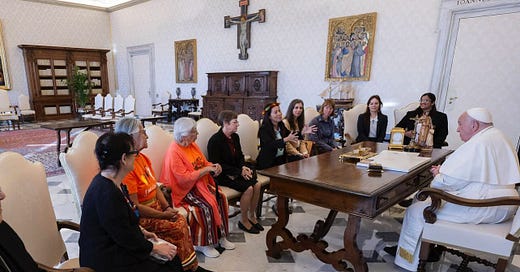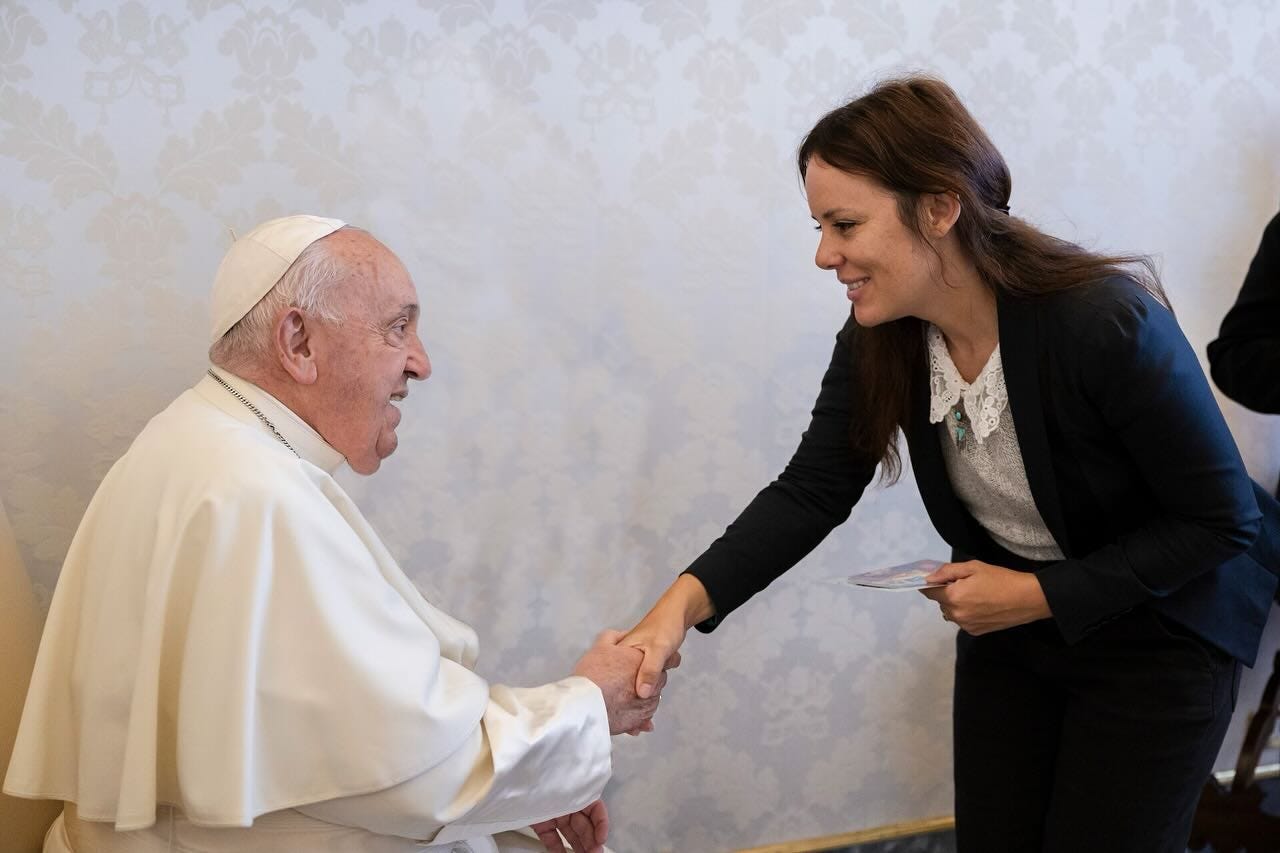The time I met the Pope.
And some other thoughts on things that are not (directly) related to a very scary election year.
Now that I have your attention…please join us November 19th at 12pm for a lunchtime Zoom conversation between my friend and long-term film protagonist, Sister Laura Vicuña Manso and her colleague Mauricio Lopez as they discuss their perspectives on the Amazonian struggle. We’ll also show a short clip from our ongoing documentary.
Sign up here.
—
Brandishing little more than my camera bag and a small blue enamel medal from Lourdes, I followed an international group of women through the dark morning streets of Rome to meet Pope Francis. I’d learned less than an hour earlier that I could join them. “You can come in, Pilar,” Laura told me over coffee, “but you’ll probably have to leave your camera.”
The group of women meeting the Pope were welcomed to do so on the basis of a Cardinal and Sister Laura’s relationship. It was, and remains, important to me to let the women we are documenting lead us within the institution on their own terms.
The experience was filled with tension. The road that these particular women are on is long and winding. From multiple countries around the world, they had come at the drop of a hat, some rearranging travel plans set months earlier, to be at the Papal Palazzo at 7:00 am on a Monday. It was September 30, 2024. The sun barely warming the Roman horizon dotted with stone pines, we walked — some slowly by cane and some quickly — to meet the Pope.
The best, most recent account of a meeting with the Pope was the humorists brought together in the summer of 2024. David Sedaris recounts for the New Yorker his incredulity at the invitation: “I didn’t click on the attachment until Stephen Colbert assured me that it was legitimate, and that the Pope really did want to meet with comics and humorists from around the world in three days’ time, and at six-forty-five in the morning.” And I won’t try to compete with that.
Of course, unlike David Sedaris, these women not only wanted to meet the Pope, but had been trying to do so for almost three years. Their message? That women — nuns, mothers, married women, indigenous women, young women, old women, widows — are in service to the Church around the world, especially on the margins of society, and want authorization to do ordained ministry as people called to that work.
To be clear, as I wandered the tall, wide, filigreed hallways of the labyrinthine palazzo, my camera bag was arraigned from me quickly by one of the many levels of men that guard the Pope in finely tailored clothes. We captured what we could on phones, as if the barriers these women face to enter this space were echoed in our restricted access to document it.
We made it to his door, and the nine women slowly filed in. We spoke in Spanish. His hands were soft and kind. His knees were hurting and he took a seat. Other words were spoken. He blessed our icons. I planned to say nothing, to stay behind the moment as an observer. But I found myself thanking him—for what, exactly, I wasn’t sure, but the words came out, something about the work and witnessing these women here, today. The group chatted at length about their work. The Pope asked us which of the candidates would be better to vote for in the U.S. election. We prayed together. Eventually he pressed a little button. We did not fall through a trap door in the floor, but a bell sounded. Our time was up. He had to be on to the next room, a giant hallway filled with hundreds of social workers, to offer his blessing. He had given us many words, some encouragement, and almost a full 30 minutes on this sunny morning. He offered us rosaries on a little plate, and our time was over.
Later this week, I also was able to attend a prayer service on October 7, to pray for the end of the war in Gaza and peace among nations. In many ways, this was one of the days in this journey where I felt most universally aligned with Pope Francis.
There are many things I’d like to share, but with a desire to protect what will become clear through the development of the film and story as you watch it, I won’t include much more here. But I am so proud of the women who bravely brought this message before Pope Francis, a person of historical significance and the most visible religious leader on the planet. We have all hoped he will listen to their requests. (If you want to respond with private questions, I’m happy to answer!)
Consensus Fidelium
A year ago, we also were here in Rome to shoot. I left hopeful. This "container," a concept/style known as “synodality,” aimed to embody a conferential, communal approach to dialogue—even (perhaps especially) with those who hold opposing views. The hope was that the recent polarization might be softened through miraculous exchange.
As we documented these women's journeys, we intersected directly with the looming, aching hierarchy, which is fumbling through scandal, controversy, and modernization while attempting to preserve entrenched structures that ultimately created the problems it is now trying to solve. The "sense" of this institution remains unclear not only to those outside its walls but also to many within the faith itself, and therein lies the rub. Jesus himself said, “A house divided against itself will not stand.” The synod was intended as an antidote to that breakdown. Whether it achieved its goals is for critics and apologists to debate; my observational takeaway is more straightforward.
As documentarians and journalists, we witnessed a diverse group engaging in dialogue around some of the most pressing social issues of our time, despite their fundamental disagreements. The groundwork acknowledged that true consensus cannot rush to conclusions or assume uniformity where it does not fully exist. There is no other place — not the political sphere or even the academy — where I have seen this done in a way that does not result in complete breakdown. There were moments when individuals expressed views so dissimilar that the conversation could have turned volatile, but they didn’t run away.
People’s awareness — that we are not as we should be or not doing as we should do — does not equate to shared and common goals. In fact, many times it moves people apart - ideologically, even physically. A lot of us want common ground to feel instant and perfect. It cannot. It’s created over time, common ground through trust. Building consensus prior to decision. And I do think this diverse group allowed themselves to be messy, which seems very important to moving forward. Moving forward begins with a clear diagnosis and consensus: a sense of what is true in a diverse group without reducing any part. Let’s call it: “Being A Mess Together.”
At the same time, I don’t think that this consensus-building process was the right method to try and enforce decisions about difficult subjects. Maybe that aspect could be different with new leaders and voices involved. I see that as a major missed opportunity.
“Who would water the flowers?”
I’ve been revisiting S-Town, the podcast made in the 20-teens by This American Life and Serial. The sad, winding tale about a misanthropic Alabaman genius clockmaker stuck in a small town of drug addicts and delinquents is one of a kind. In it, John B. McLemore grieves his Sh*t-town, his Sh*t-country, his Sh*t-world. His greatest gripes tend to center on climate change, which he looks at as a nearing apocalypse creeping up on him through his rose-maze where droughts and floods have created a less habitable ecosystem for his finely pruned flowerbeds.
When Brian Reed of Serial asks him why he doesn’t leave — why not just move away from the sh*t?? — John B. seems to reflect on the needs of the things around him. Who would water the flowers? Who would take in the stray dogs? The stray folks? John B. seems like many people I personally know who feel their place is to be present to things that perhaps the mainstream world has tended to discard. People who cannot leave because they wonder: who would listen to the sounds, see the things, taste the food, love the people, tend the ground that has been rejected? This kind of work is patently not about self-improvement. Or optimizing. Perhaps it’s also not enough for world-improvement. But, world change is the long game. It’s the possibility of change that goes on beyond one’s own life. It’s the possibility of liberation.
Here’s the thing: I know this isn’t visibly radical. I realize this isn’t pushing in the way many people want to see pushing happen. People ask me constantly why women and other marginalized voices in the church don’t just leave. This is a question posed to people in many different situations and, of course, in some there are moments that there is no choice but to go. But for some, it’s still a choice — even a desire — to stay. They still see themselves there, a part of it. Because who would water the flowers?
Musings
Observing: Día de los Muertos, All Saints and All Soul’s, Halloween, however you come by it :). Bless up to the ancestors.
Music: Patterns In Repeat, new album by Laura Marling (on repeat).
Revisiting S-Town, which, despite (a ton of apparently??) criticism, holds up as a complex narrative on love for tragically flawed places (e.g. Earth).
…Through doing that I stumbled upon Brian Reed from this American life’s NEW podcast. Which is about the existential crisis in journalism these days — feels very doc adjacent in the “who-in-the-audacity” of making anything nonfiction related.
…Led me to this video episode they did, featuring a VERY silver fox, Ira Glass. All of which is, I think, good.





